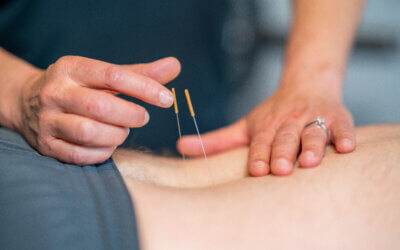Some people may think that exercising will only increase their lower back pain, and others might even have developed their pain after doing exercises with poor form. However, physical therapy exercises can be a potent tool for reducing lower back pain.
Lower back pain is a very common problem for the U.S. population, and medical research shows that approximately 31 million Americans are living with lower back pain right now. Working with a physical therapist can be an effective way to reduce your lower back pain. A therapy option that many physical therapists use for lower back pain is therapeutic exercises; here are a few exercises your therapist may prescribe:
- Lying side twist
Purpose: This physical therapy exercise can help patients stretch the muscles in their sides and lower back, which can be useful for reducing lower back pain.
How to do the lying side twist exercise:
- Lie on your back with your arms stretched out to the side so that your upper body forms a “T.”
- Bend both knees so that your feet are flat on the floor.
- Slowly drop your knees to the right until they reach the ground.
- Hold this stretch for five to 10 seconds.
- Slowly lift your knees back up, and then let them slowly drop to the left.
- Hold this stretch for five to 10 seconds.
- Continue to repeat the stretch until both sides of your body have been stretched 10 times.
- Back extension stretch
Purpose: Physical therapists often use the back extension stretch for people who have lower back pain that eases when standing or lying down.
How to do the back extension stretch:
- Lie down on your stomach with your legs straight behind you.
- Place your forearms on the ground at about chest level with your elbows tucked into your sides.
- Press down into your forearms, relax your lower back and slowly raise your upper body off the floor.
- Stop when you feel a moderate stretch in your lower back.
- Hold this stretch for 20 to 30 seconds.
- Slowly lower your upper body back to the ground.
- Repeat this stretch until you’ve done three to five repetitions.
- Pelvic tilt
Purpose: The pelvic tilt is a physical therapy exercise used for helping people stretch their lower back, strengthen their abs and reduce pain.
How to do the pelvic tilt exercise:
- Lie down flat on your back.
- Bend your knees so that your feet are flat on the floor.
- Tighten your stomach muscles and pull your belly button in toward your spine. Your lower back should press into the floor, and your hips and pelvis should rock backward.
- Hold this position for three to five seconds.
- Release your abdominal muscles.
- Repeat this exercise until you’ve done 10 to 15 repetitions.
Find effective physical therapy for lower back pain at Continuum Wellness
You don’t have to keep living with lower back pain. Our physical therapy team at Continuum Wellness is primed to help you find relief from your pain. We offer free screenings that can assess your lower back and determine the source of your pain. In addition, our specialists excel at building unique therapy plans to fit each patient’s needs. You can even sign up for at-home care and virtual therapy appointments with us that allow you to get help right from home.
Contact our team today for more information about how we can assist with your lower back pain or to schedule an initial appointment.



